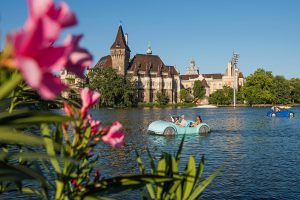On 17 November, Budapest celebrates its 145th anniversary. Of course, just like most aging dames, Budapest is way older than what she prefers to admit: its history actually dates back to Roman times! That doesn’t change the fact that it was on this day in 1873 when the city under its current name was officially born, by the joining together of the then-separate towns of hilly Buda, urban Pest, and ancient Óbuda. Let’s commemorate the birthday of our beloved capital with a few fun facts about the Magyar metropolis!

With over 12 spas, and 120 thermal springs and wells within its borders, Budapest is the official city of baths, boasting more hot springs than any other large city on the planet. The first public baths were built by the Romans some 1,800 years ago, while spa culture was revived by the Ottoman Turks in the 16th century, and has been going strong ever since.
The number 96 has a distinguished role in Budapest’s history. Both the Parliament and St. Stephen’s Basilica are 96 meters tall, as to represent the equal importance of secular and religious powers. The M1 metro line (the first underground railway system in continental Europe) was opened in 1896, as part of the Millennium Celebrations, commemorating the arrival of the Hungarian tribes to the Carpathian Basin in 896. Up until a few months ago, it was an unspoken rule that no building should be higher than 96 meters. With the ongoing construction of the 120 meters tall MOL HQ, this rule seems to be no longer valid.
Besides a whopping number of hot springs, Budapest also features the world’s largest geothermal cave system under its streets and houses. With more than 200 caves and tunnels hidden beneath the surface, Budapest is a true caveman’s paradise! Caverns open to the public include the Szemlő-hegyi and Pál-völgyi caves, as well as the Hospital in the Rock in Buda Castle, the Cave Church at Gellért Hill, and the Kőbánya cellar system.
Present-day Budapest was first settled by the ancient Romans in the 1st century AD, and while the subsequent ages weren’t too kind on their built heritage, there’s virtually no large-scale construction in the city during which workers don’t bump into the base of some Roman villa. Visible remnants of the Empire include two amphitheatres (Aquincum and Nagyszombat utca), a huge ruin garden (Aquincum), a bathing complex (Thermae Maiores), an aqueduct (Szentendrei út), a fortress (Március 15. tér), an ancient Christian chapel (Cella Trichora), and a residential house complete with a beautiful mosaic (Hercules villa).
As part of its Ottoman past, Budapest hosts Islam’s northernmost holy site: the tomb of Gül Baba is situated at the end of a steep and romantic cobblestoned street on Rózsa Hill, and marks the burial place of a Turkish dervish who died in 1541 during the siege of Buda. Built between 1543 and 1548, the recently refurbished monument is one of the few remaining Turkish buildings in Budapest.




